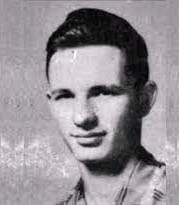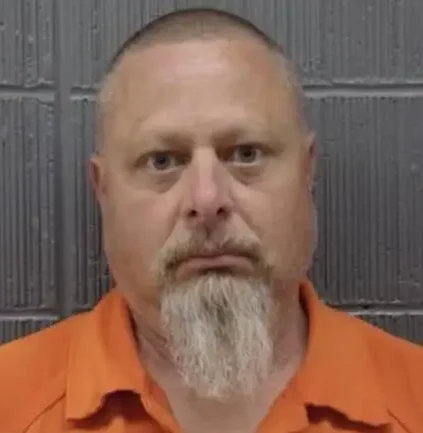
John Wayne Gacy (March 17, 1942 – May 10, 1994) was an American serial killer and sex offender who raped, tortured, and murdered at least 33 young men and boys in Norwood Park Township, near Chicago, Illinois. His conviction for thirty-three murders, by one individual, then covered the most homicides in United States legal history. Gacy was sentenced to death on March 13, 1980. He was executed by lethal injection at Stateville Correctional Center on May 10, 1994.
In 1971, Gacy established a part-time construction business, PDM Contractors (for “Painting, Decorating, and Maintenance”). With the approval of his probation officer. Gacy worked evenings on his construction contracts while working as a cook during the day. Initially, he undertook minor repair work, but later expanded to include projects such as interior design, remodeling, and landscaping. In mid-1973, Gacy quit his job as a cook so he could commit fully to his construction business. Nobody knew for his criminal record. He had been convicted of sodomy. By 1975, PDM was expanding rapidly and Gacy was working up to sixteen hours per day. In March 1977, he became a supervisor for PE Systems, a firm specializing in the remodeling of drugstores. Between PE Systems and PDM, Gacy worked on up to four projects simultaneously and frequently traveled to other states. By 1978, PDM’s annual revenue was over $200,000 (200,000$ in 1978 is equivalent in purchasing power to about 963,726.99 today). Gacy was a millionaire from today’s perspective.
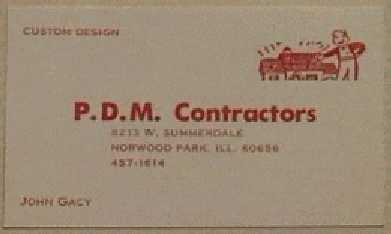
Gacy was active in his local community and helpful towards his neighbors; he willingly loaned his construction tools and plowed snow for neighborhood free of charge. From 1974 to 1978, he hosted themed annual summer parties in his ranch-style house. These events were attended by up to 400 people, including politicians and business associates. He was married twice.
He lived there until his arrest in December 1978 and, according to Gacy, committed all his murders there.
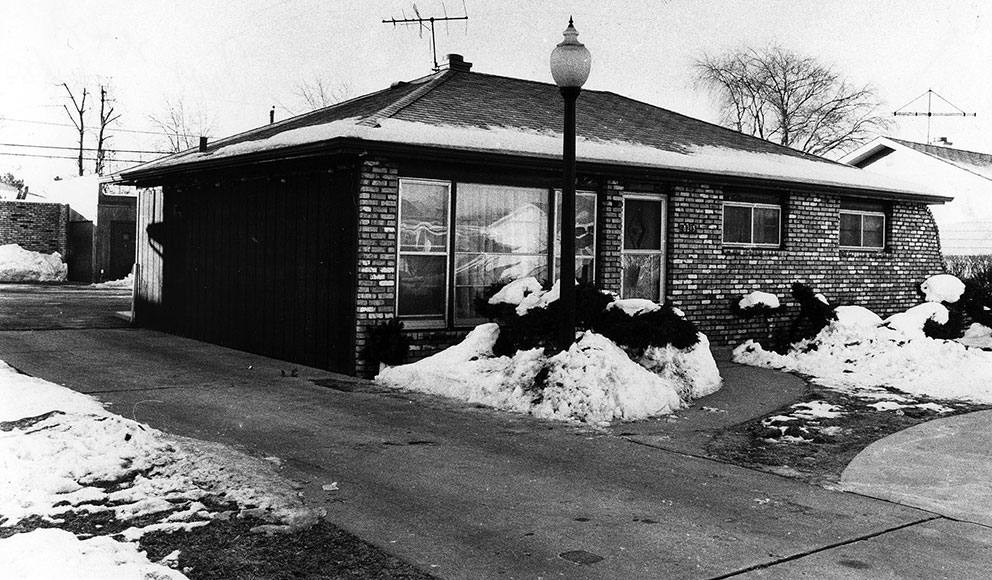
Gacy was also active in politics, a shockingly public pursuit for a man with so many figurative skeletons in his closet and literal ones in his crawlspace. Gacy was active in the Chicago-area Democratic Party and it was through that he met then-first lady Rosalynn Carter on May 6, 1978, six years after his first murder and seven months before his final arrest. Gacy entered local Democratic Party politics, initially offering use of his employees to clean party headquarters at no charge. He was rewarded with an invitation to serve on the Norwood Park Township street lighting committee, subsequently earning the title of precinct captain. In 1975, Gacy was appointed director of Chicago’s annual Polish Constitution Day Parade. He had Polish and Danish ancestry.
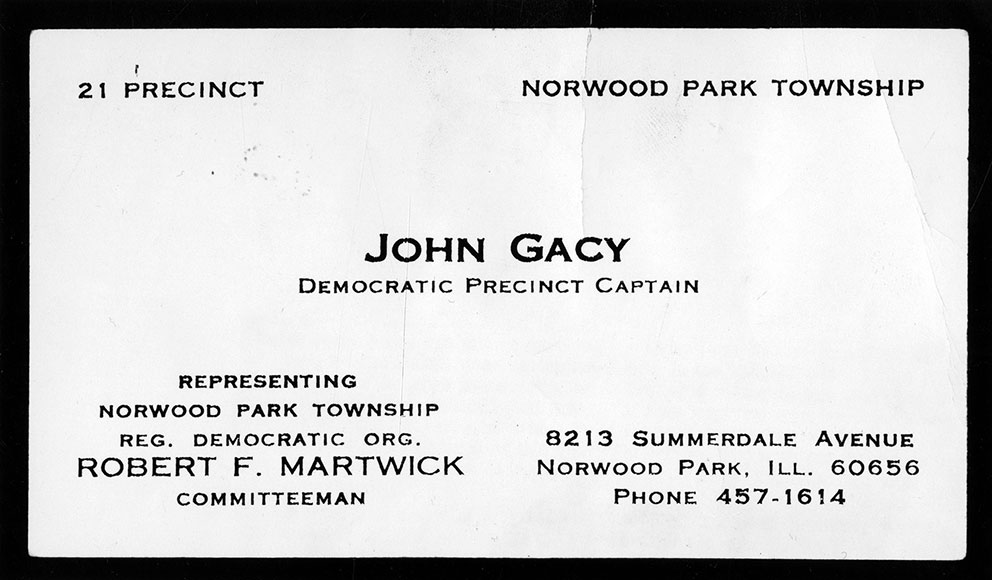
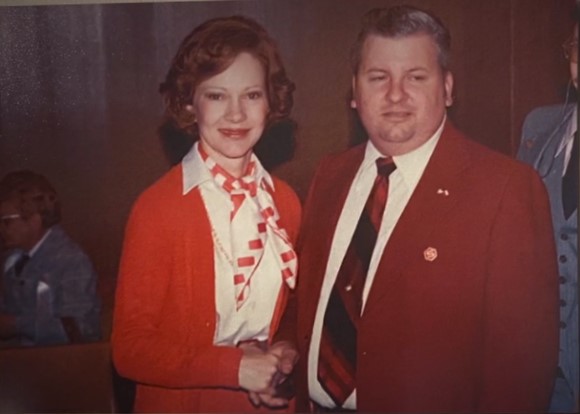
The event later became an embarrassment to the United States Secret Service.
Through his membership in a local Moose Club Gacy became aware of a “Jolly Joker” clown club, whose members regularly performed at fundraising events and parades in addition to voluntarily entertaining hospitalized children. In late 1975, Gacy joined the clown club and created his own characters “Pogo the Clown” and “Patches the Clown”, devising his own makeup and costumes. He described Pogo as a “happy clown”, whereas Patches was a “more serious” character. Gacy seldom earned money for his performances and later said that acting as a clown allowed him to “regress into childhood”. Gacy’s voluntary public service as a clown throughout the years of his murders led to him being known as the “Killer Clown’’.

Much of PDM’s workforce consisted of high school students and young men. He was praised for hiring high school students, because they could earn some money. On the other hand, it was sensible decision because they were paid less. He complained about flooding and allegedly it caused smells so his employees dug crawl space under his house according to his words in his last interview with FBI agent Robert Ressler.
Twenty-six victims were buried in the crawl space of his home, and three were buried elsewhere on his property; four were discarded in the Des Plaines River.
One of the first things Gacy told investigators after his arrest was that he had not acted alone in several of the murders: he asked whether “my associates” had been arrested. When questioned whether these associates had participated directly or indirectly in the killings, Gacy replied, “Directly”. He later claimed Cram and Rossi were involved in several of the murders. Some defense attorneys and investigators researching the possibility Gacy had not acted alone in several of the murders have said there is “overwhelming evidence Gacy worked with an accomplice”. In the 1980s, Gacy informed FBI profiler Robert Ressler that “two or three” PDM employees had assisted in several murders. So maybe they had known the purpose of the crawl space when they were digging trenches, if Gacy said the truth. Ressler believed there were unexplained avenues to the case and that Gacy had killed more than 33 victims in multiple states. Gacy neither confirmed nor denied Ressler’s suspicions. Jeffrey Rignall, who had been assaulted and tortured by Gacy in March 1978, was adamant that at one point during his ordeal, a young man with brown hair had watched his abuse, and that he saw a light come on elsewhere in the house. Three days before his arrest, two officers followed Gacy to a bar where he met two employees—Michael Rossi and Ed Hefner. An anxious Gacy was observed walking with the two out of earshot of the officers to talk before returning closer. Gacy said to both young men: “You’d better not let me down, you fuckers. You owe it to me.” The officers then overheard sections of a hushed conversation between Gacy and the two during which Rossi asked Gacy, “And what? Buried like the other five?”
His victims included people he knew and random individuals lured from Chicago’s Greyhound Bus station, Bughouse Square, or off the streets with the promise of a job with PDM, an offer of drink and/or drugs, or money for sex. Some victims were grabbed by force; others were conned into believing Gacy (who often carried a sheriff’s badge and had spotlights on his black Oldsmobile) was a policeman. Gacy usually lured a lone victim to his house, although on more than one occasion Gacy had what he called “doubles” – two killed in the same evening. Inside Gacy’s home, his usual modus operandi was to ply a youth with drink, drugs, or generally gain his trust. He would then produce a pair of handcuffs to “show a magic trick”, sometimes as part of a clowning routine. He typically cuffed his own hands behind his back, then surreptitiously released himself with a hidden key. He then offered to show his intended victim the trick. With his victim restrained, Gacy proceeded with rape and torture. He tortured them horrifically. It was a prolong torture. He was inspired by the Houston Mass Murders. He also taunted many victims throughout their abuse, and was known to have partly drowned several in the bathtub before repeatedly reviving them. Gacy typically murdered his victims by placing a rope tourniquet around their neck and progressively tightening it with a hammer handle. He referred to this as the “rope trick”, frequently informing his victim, “This is the last trick.” Occasionally, the victim convulsed for an “hour or two” before dying, although several victims died by asphyxiation from cloth gags stuffed deep in their throats. Gacy usually stored the victims’ corpses under his bed for up to twenty-four hours before burying them in the crawl space, where he periodically poured quicklime to hasten decomposition. Some were taken to his garage and embalmed prior to burial.
Only 28 of Gacy’s victims have been conclusively identified. The youngest were Samuel Stapleton and Michael Marino, both 14; the eldest were Francis Alexander and Russell Nelson, both 21.
| Name | Age | Date | Location found |
| Timothy Jack McCoy | 16 | murdered on 3 January 1972 | found in the crawl space |
| John Butkovich | 18 | murdered on 31 July 1975 | found in the garage |
| Darrell Julius Samson | 18 | murdered on 6 April 1976 | found under the dining room |
| Randall Wayne Reffett | 15 | murdered on 14 May 1976 | found in the crawl space |
| Samuel G Dodd Stapleton | 14 | murdered on 14 May 1976 | found in the crawl space |
| Michael Lawrence Bonnin | 17 | murdered on 3 June 1976 | found in the crawl space |
| William Huey Carroll Jr | 16 | murdered on 13 June 1976 | found in the crawl space |
| James Byron Haakenson | 16 | murdered on 5 August 1976 | found in the crawl space |
| Rick Louis Johnston | 17 | murdered on 6 August 1976 | found in the crawl space |
| Kenneth Ray Parker | 16 | murdered on 24 October 1976 | found in the crawl space |
| Michael M Marino | 14 | murdered on 24 October 1976 | found in the crawl space |
| William George Bundy | 19 | murdered on 26 October 1976 | found in the crawl space |
| Francis Wayne Alexander | 21 | murdered on 1 December 1976 | found in the crawl space |
| Gregory John Godzik | 17 | murdered on 12 December 1976 | found in the crawl space |
| John Alan Szyc | 19 | murdered on 20 January 1977 | found in the crawl space |
| Jon Steven Prestidge | 20 | murdered on 15 March 1977 | found in the crawl space |
| Matthew Walter Bowman | 19 | murdered on 5 July 1977 | found in the crawl space |
| Robert Edward Gilroy Jr | 18 | murdered on 15 September 1977 | found in the crawl space |
| John Antheney Mowery | 19 | murdered on 25 September 1977 | found in the crawl space |
| Russell Lloyd Nelson | 21 | murdered on 17 October 1977 | found in the crawl space |
| Robert David Winch | 16 | murdered on 10 November 1977 | found in the crawl space |
| Tommy Joe Boling | 20 | murdered on 18 November 1877 | found in the crawl space |
| David Paul Talsma | 19 | murdered on 9 December 1977 | found in the crawl space |
| William Wayne Kindred | 19 | murdered on 16 February 1978 | found in the crawl space |
| Timothy David O’Rourke | 20 | murdered 16 – 23 June 1978 | found in Des Plaines River |
| Frank William Landingin | 19 | murdered on 4 November 1978 | found in Des Plaines River |
| James Mazzara | 20 | murdered on 24 November 1978 | found in Des Plaines River |
| Robert Jerome Piest | 15 | murdered on 11 December 1978 | found in Des Plaines River |
| Gender | Age | Location found |
| Male aged 14–18 | murdered 3 January 1972 – 31 July 1975 | found in the backyard |
| Male aged 23–30 | murdered 13 June – 5 August 1976 | found in the crawl space |
| Male aged 17–22 | murdered 6 August – 5 October 1976 | found in the crawl space |
| Male aged 15–24 | murdered 6 August – 24 October | found in the crawl space |
| Male aged 17–21 | murdered 15 March – 5 July 1977 | found in the crawl space |
Gacy would often proposition his workers for sex, or insist on sexual favors in return for lending his vehicles, financial assistance or promotions. Gacy also claimed to own guns, once telling an employee, “Do you know how easy it would be to get one of my guns and kill you—and how easy it would be to get rid of the body?”
In 1973, Gacy and a teenage employee traveled to Florida to view a property Gacy had purchased; while there, Gacy raped the employee in their hotel room. After returning to Chicago, this employee drove to Gacy’s house and beat him in his front yard. Gacy told his wife he had been attacked for refusing to pay him for poor quality painting work.
In May 1975, Gacy hired 15-year-old Anthony Antonucci. Two months later, he went to Antonucci’s home, knowing the youth had an injured foot. He tried to cuff him and rape him but didn’t succeed because Antonucci was a high school wrestler.
Robert Piest
On the afternoon of December 11, 1978, Gacy visited the Nisson Pharmacy in Des Plaines, to discuss a potential remodeling deal with the store owner. While he was within earshot of 15-year-old part-time employee Robert Piest, Gacy mentioned his firm often hired teenage boys at a starting wage of $5 per hour—almost double the pay Piest earned at the pharmacy.
Shortly after Gacy left, Piest’s mother arrived at the store to drive her son home so the family could celebrate her birthday together. Piest asked his mother to wait, adding that “some contractor wants to talk to me about a job”. He left the store at 9:00 p.m., promising to return shortly. He didn’t come back and his mother even, allegedly, went to Gacy’s house and he said he didn’t know what she was talking about.
Piest was murdered shortly after 10:00 p.m. at Gacy’s home. Gacy later stated that at his house, he gave Piest a soft drink before asking whether there was anything he “wouldn’t do for the right price”, to which Piest replied that he did not mind working hard. In response, Gacy stated “good money” could be earned by hustling, although Piest was dismissive. Gacy then duped Piest into donning handcuffs. Gacy’s subsequent statements regarding the events varied, although in one of his initial statements, he claimed Piest failed to resist as he removed the boy’s trousers. He also stated that as he placed the rope around Piest’s neck, the boy was “crying, scared’’. Gacy admitted to having received a phone call from a business acquaintance as Piest lay dying.
Investigation
When Piest failed to return, his family filed a missing person report with the Des Plaines police. The store owner, Torf, named Gacy as the contractor Piest had most likely left the store to talk to. Robert Piest had a bright future and was known to be a good boy, so police didn’t consider him to be a runaway.
Lieutenant Joseph Kozenczak, whose son attended Maine West High School like Piest, chose to investigate Gacy further. A check of Gacy’s criminal background revealed that he had an outstanding battery charge in Chicago and had been imprisoned in Iowa for the sodomy of a 15-year-old boy.
Gacy promised to come to the station later that evening to make a statement, indicating he was unable to do so at that moment as his uncle had just died. When questioned as to how soon he could come to the police station, he responded, “You guys are very rude. Don’t you have any respect for the dead?”
At 3:20 a.m., Gacy arrived at the police station covered in mud, claiming he had been involved in a car accident.
First search warrant
Suspecting Gacy might be holding Piest at his home, Des Plaines police obtained a search warrant on December 13. This search revealed several suspicious items, including several police badges; a starter pistol; a syringe and hypodermic needle; handcuffs; several driver’s licenses; a blue hooded parka; and underwear too small to fit Gacy. They also found a class ring engraved with the initials J.A.S.Later, they found out later the ring belonged to one of his victim, they had considered a runaway and a Nisson Pharmacy photo receipt in a trash can where Piest worked, alongside a 36-inch (91 cm) section of nylon rope.
Surveillance
The Des Plaines police confiscated Gacy’s Oldsmobile and other PDM work vehicles. Surveillance teams monitored Gacy as the investigation continued. The following day, investigators received a phone call from Michael Rossi, who informed the investigators of Gregory Godzik’s disappearance and the fact that another PDM employee, Charles Hattula, had been found drowned in an Illinois river earlier that year. In an interview with Gacy’s former wife they learned of the disappearance of John Butkovich. The same day, the class ring was traced to a John Alan Szyc. An interview with Szyc’s mother revealed that several items from her son’s apartment were also missing, including a Motorola television.
By December 16, Gacy was becoming affable with the surveillance detectives, regularly inviting them to join him for meals in restaurants and occasionally for drinks in bars or at his home. Knowing these officers were unlikely to arrest him on anything trivial, he taunted them by flouting traffic laws and succeeded in losing his pursuers more than once. That afternoon, Cram consented to a police interview, in which he revealed that, because of his poor timekeeping, Gacy had once given him a watch, explaining he got it “from a dead person”.
Investigators conducted a formal interview of Rossi on December 17. He informed them Gacy had sold him Szyc’s vehicle, explaining that he had bought the car from Szyc because he needed money to move to California. A further examination of Gacy’s Oldsmobile revealed a small cluster of fibers in the trunk, suspected to be human hair. That evening, three trained search dogs were used to determine whether Piest had been present in any of Gacy’s vehicles. One laid on the passenger seat of Gacy’s Oldsmobile in what the dog’s handler informed investigators was a “death reaction”, indicating Piest’s body had been present.
That evening, Gacy invited detectives Albrecht and Hachmeister to a restaurant for a meal. Early on December 18, he invited them into another restaurant where, over breakfast, he discussed his business, his marriages and his clowning. During the conversation, Gacy remarked: “You know … clowns can get away with murder.”
By December 18, Gacy was beginning to display signs of strain from the constant surveillance: he was unshaven, looked tired and anxious and was drinking heavily. That afternoon, he drove to his lawyers’ office to prepare a $750,000 civil suit against the Des Plaines police, demanding that they cease their surveillance.
Second search warrant
The same evening, Rossi was interviewed a second time. This time he was more cooperative. He informed detectives that in the summer of 1977, at Gacy’s behest, he had spread ten bags of lime in the crawl space of Gacy’s house.
On December 19, investigators began compiling evidence for a second search warrant for Gacy’s house. The same day, Gacy’s lawyer, Sam Amirante, filed the civil suit against the Des Plaines police. The hearing for the suit was scheduled for December 22. That afternoon, Gacy invited the surveillance detectives inside his house again. As Robinson distracted Gacy with conversation, Schultz walked into Gacy’s bedroom in an unsuccessful attempt to write down the serial number of the Motorola television they suspected belonged to Szyc. While flushing Gacy’s toilet, the officer noticed a smell he suspected could be that of rotting corpses emanating from a heating duct. The officers who had searched Gacy’s house previously had failed to notice this, as the house had been cold.
Investigators interviewed both Cram and Rossi on December 20. When questioned as to where he believed Gacy had concealed Piest’s body, Rossi replied Gacy may have placed the body in the crawl space. They dug trenches in the crawl space with some other teenagers.
When asked whether he had been to the crawl space, Cram replied he had once been asked by Gacy to spread lime down there and had also dug trenches, which Gacy had explained were for drainage pipes. Cram stated these trenches were 2 feet (0.6 m) wide, 6 feet (1.8 m) long and 2 feet deep – the size of graves.
Confession
On the evening of December 20, Gacy drove to his lawyers’ office, in Park Ridge to attend a scheduled meeting, ostensibly to discuss the progress of his civil suit. “You said you had something new to tell me! Something important!” Gacy picked up the newspaper, pointed to the front-page article covering the disappearance of Piest and said, “This boy is dead. He’s dead. He’s in a river.”
Gacy then proceeded to give a rambling confession that ran into the early hours of the following morning. He began by stating he had “been the judge … jury and executioner of many, many people”, and that he now wanted to be the same for himself. He stated he had murdered “at least thirty” victims, most of whom he had buried in his crawl space, and had disposed of five other bodies in the Des Plaines River. Gacy dismissed his victims as “male prostitutes”, “hustlers” and “liars”, adding he sometimes awoke to find “dead, strangled kids” with their hands cuffed behind their back.
Gacy later recollected his memories of his final day of freedom as being “hazy”, adding he knew his arrest was inevitable and that he intended to visit his friends and say his farewells. After leaving his lawyers’ office, Gacy drove to a gas station where he handed a small bag of cannabis to the attendant, who immediately handed the bag to the surveillance officers, adding that Gacy had told him, “The end is coming (for me). These guys are going to kill me.” Gacy then drove to the home of a fellow contractor and friend, Ronald Rhode. Gacy hugged Rhode before bursting into tears and saying, “I’ve been a bad boy. I killed thirty people, give or take a few.” Gacy left Rhode and drove to Cram’s home to meet with Cram and Rossi. The surveillance officers noted he was holding a rosary to his chin, praying while he drove along the expressway. After talking with Cram and Rossi, Gacy had Cram drive him to a scheduled legal meeting. Cram informed the surveillance officers that Gacy had told him and Rossi that he had confessed to over thirty murders with his lawyers the previous evening. Gacy then had Cram drive him to Maryhill Cemetery, where his father was buried.
As Gacy drove to various locations that morning, police outlined the formal draft of their second search warrant, specifically to search for Piest’s body in the crawl space. On hearing from the surveillance detectives that, in light of his erratic behavior, Gacy might be about to commit suicide, police decided to arrest him on a charge of possession and distribution of cannabis in order to hold him in custody, as the formal request for a second search warrant was presented. At 4:30 p.m. on December 21, the eve of the hearing of Gacy’s civil suit, a second search warrant was granted.

Armed with the signed search warrant, police and evidence technicians drove to Gacy’s home. They found Gacy had unplugged his sump pump, flooding the crawl space with water; they replaced the plug and waited for the water to drain. Evidence technician Daniel Genty then entered the 28-by-38-foot (8.5 m × 11.6 m) crawl space, crawled to the southwest area and began digging. Within minutes, he uncovered putrefied flesh and a human arm bone. Genty shouted to the investigators that they could charge Gacy with murder, adding, “I think this place is full of kids.”
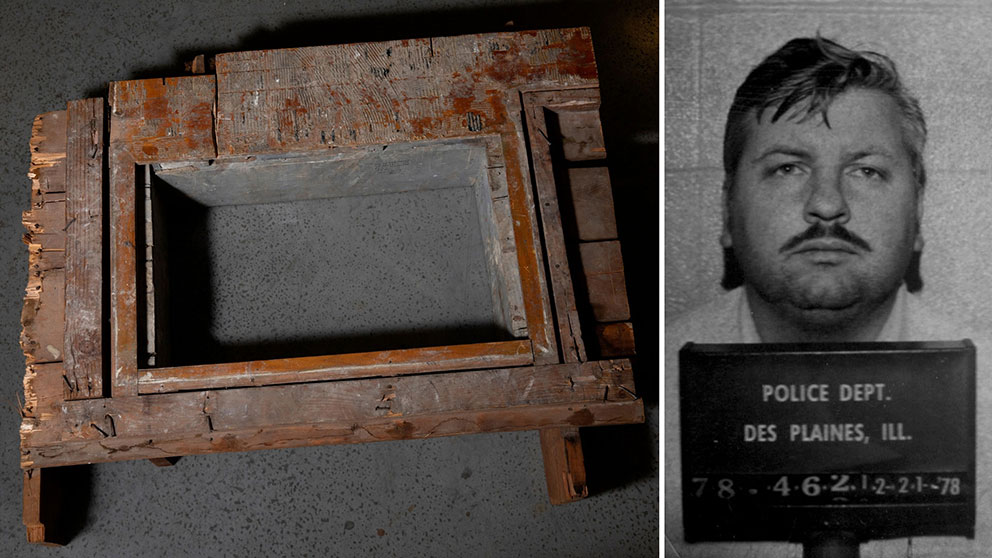
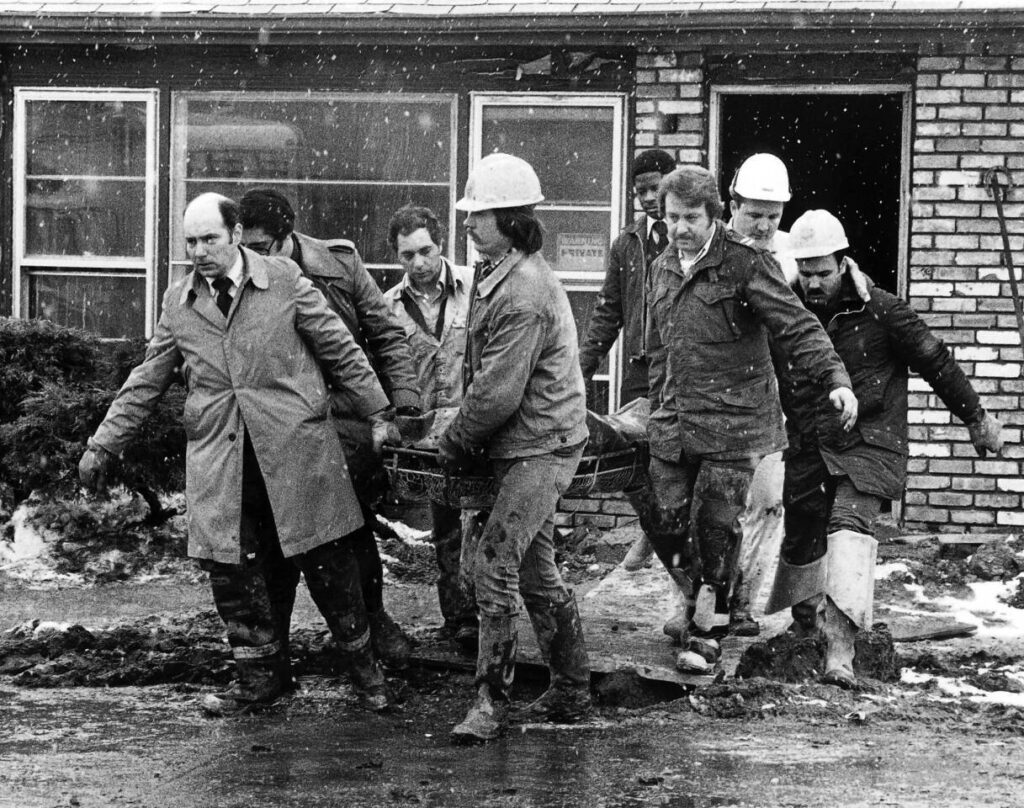
After being informed that the police had found human remains in his crawl space and that he would now face murder charges, Gacy told officers he wanted to “clear the air”. In the early morning hours of December 22, and in the presence of his lawyers, Gacy provided a formal statement in which he confessed to murdering approximately thirty young males—all of whom he claimed had entered his house willingly. Some victims were referred to by name, but Gacy claimed not to know or remember most of the names. He claimed all were teenage male runaways or male prostitutes, the majority of whom he had buried in his crawl space. In a rambling, verbal statement lasting several hours, Gacy tells police he has killed 32 young men after having sexual relations with them. He talks of himself in the third person, saying the slayings and sex acts were committed by “Jack” or “John.” Gacy claimed to have dug only five of the graves in this location and had his employees (including Godzik) dig the remaining trenches so that he would “have graves available”. When shown a driver’s license issued to a Robert Hasten which had been found on his property, Gacy claimed not to know him but admitted that this license had been in the possession of one of his victims. In January 1979, he had planned to conceal the corpses even further by covering the entire crawl space with concrete. Description detectives gave about his behavior points to borderline personality disorder, among other issues.
When questioned specifically about Piest, Gacy confessed to luring him to his house and strangling him on December 11. He also admitted to having slept alongside Piest’s body that evening, before disposing of the corpse in the Des Plaines River in the early hours of December 13. On his way to the police station, he had been in a minor traffic accident after disposing of Piest. His vehicle had slid off an ice-covered road and had to be towed free.
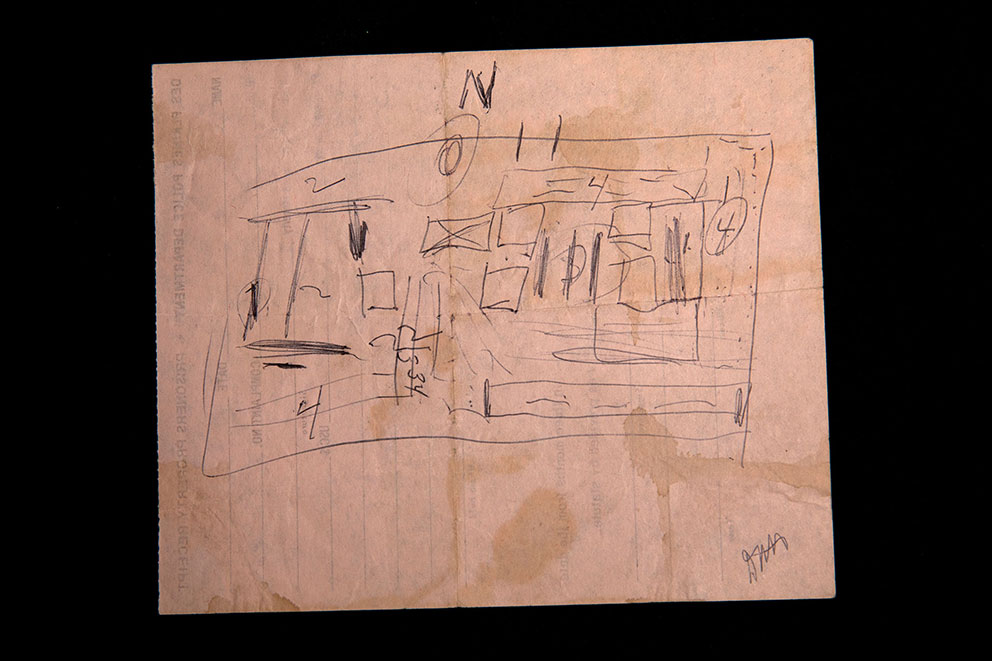
To assist officers in their search, Gacy drew a rough diagram of his basement to indicate where their bodies were buried.
As the flooring and walls of the property were dismantled, additional evidence including identification cards and further deviant sex books were discovered.
The investigation into the disappearance of Des Plaines teenager Robert Piest led to Gacy’s arrest on December 21, 1978. Police faced harsh criticism for not investigating disappearances of many ordinary, marginalized boys and just portrayed them as runaways and that they reacted only when a boy, with a bright future disappeared.
On trial for murders, at the request of his defense counsel, Gacy spent over three hundred hours with doctors at the Menard Correctional Center in Chester in the year before his trial. He underwent a variety of psychological tests to determine whether he was mentally competent to stand trial. Gacy attempted to convince the doctors that he had multiple personality disorder. He claimed to have four personalities: the hard-working, civic-minded contractor, the clown, the active politician, and a policeman called Jack Hanley, whom he referred to as “Bad Jack”. When Gacy had confessed to police, he claimed to be relaying the crimes of Jack, who detested homosexuality and viewed male prostitutes as “weak, stupid and degraded scum”. His lawyers opted to have Gacy plead not guilty by reason of insanity.
The defense produced several psychiatric experts who had examined Gacy; three testified they found him to be a paranoid schizophrenic with multiple personalities.
On being sentenced, Gacy was transferred to the Menard Correctional Center, where he remained on death row for 14 years. Isolated in his prison cell, Gacy began to paint. Gacy’s paintings have been displayed at exhibitions and sold at auction. After Gacy’s death was confirmed his brain was removed. It is in the possession of Helen Morrison, a witness for the defense at Gacy’s trial, who has interviewed Gacy and other serial killers in an attempt to isolate common personality traits of violent psychopaths. He was cremated.

According to published reports, Gacy was a diagnosed psychopath who did not express any remorse for his crimes.
What do we know about John Wayne Gacy’s life?
John Wayne Gacy was born in Chicago, Illinois, the second of three children and only son of John Stanley Gacy and Marion Elaine Robison. His father was an auto repair machinist and World War I veteran, and his mother was a homemaker.
Gacy was close to his mother and two sisters, but had a difficult relationship with his father, an alcoholic who was verbally and physically abusive to his family. The elder Gacy frequently belittled his son, calling him “dumb and stupid” and comparing him unfavorably with his sisters. One of Gacy’s earliest childhood memories was of his father beating him at age four for accidentally disarranging car engine components. His mother tried to shield her son from his father’s abuse, which resulted in accusations that he was a “sissy” and a “mama’s boy” who would “probably grow up queer”. In 1949, Gacy’s father whipped him after he and another boy were caught sexually fondling a young girl. The same year, a family friend began to occasionally molest Gacy. Gacy never told his father, afraid that his father would blame him. Despite their challenging relationship, Gacy loved his father,but felt he was “never good enough” in his father’s eyes.
Gacy was an overweight and unathletic child. Because of a heart condition, he was told to avoid sports. In the fourth grade, Gacy fell and hurt his head badly. Actually, that’s something psychiatrists have found to be a contributing factor for what he became: head injury – there is a change in personality. Here we can read and hear different psychiatrists and psychologists arguing in favor two disorders: sociopathy, environmentally based, contrary to psychopathy, genetically based. Dr. Hare says it’s only the question of origin, but not so important.
He began to experience blackouts. He fainted many times. He was hospitalized on occasion because of these episodes and also, in 1957, for a burst appendix. Gacy later estimated that between the ages of 14 and 18, he had spent almost a year in hospital; he attributed the decline of his grades to missing school. Gacy’s medical condition was never conclusively diagnosed; his father suspected he was malingering. On one occasion, he openly accused his son of faking as he lay in a hospital bed. Childhood abuse is one more factor, we often see in serial killers. There are several factors and in Gacy’s childhood there are two, listed as prevalent among serial killers.
There are explanations, but good man couldn’t have done it. He must be a psychopathic and sadistic personality and these factors made him exhibit it in the way he did.
In 1962, Gacy left home and drove to Las Vegas, Nevada, with $136 to his name in the hope of residing with a cousin. Gacy worked in the Las Vegas ambulance service before being transferred to Palm Mortuary. He worked as a mortuary attendant for three months, observing morticians embalming bodies and occasionally serving as a pallbearer. He slept on a cot behind the embalming room and later confessed that one evening, while alone, he clambered into the coffin of a teenage male, embracing and caressing the body before experiencing a sense of shock. This experience prompted Gacy to return home. He denied that incident had ever happened in his last interview with FBI agent Robert Ressler, but he was also claiming that he was innocent. He complained that clowns were given a bad name, because of how they portrayed him.
Shortly thereafter, Gacy enrolled at Northwestern Business College, despite having failed to complete high school. He graduated in 1963 and took a management trainee position with the Nunn-Bush Shoe Company. In 1964, the company transferred him to Springfield, Illinois, to work as a salesman, and eventually promoted him to department manager. In March of that year, he became engaged to Marlynn Myers, a co-worker. Gacy and Myers married in September 1964. Marlynn’s father subsequently purchased three Kentucky Fried Chicken (KFC) restaurants in Waterloo, Iowa. The couple moved there so Gacy could manage the restaurants, with the understanding that they would move into Marlynn’s parents’ former home. The offer was lucrative: Gacy would receive $15,000 per year (the equivalent of about $153,000 as of 2024), plus a share of the restaurant’s profits. Gacy opened a “club” in his basement where his employees could drink alcohol and play pool. Although Gacy employed teenagers of both sexes, he socialized only with the males. Gacy gave many of them alcohol before he made sexual advances; if they rebuffed him, he would claim his advances were jokes or a test of morals. Gacy’s wife gave birth to a son in February 1966 and a daughter in March 1967. Gacy later described this period of his life as “perfect”—he had finally earned his father’s approval. When Gacy’s parents visited in July 1966, his father privately apologized for the abuse he had inflicted before happily saying, “Son, I was wrong about you,” as he shook Gacy’s hand. In Waterloo, Gacy joined the local Jaycees chapter, regularly offering extended hours to the organization in addition to the twelve- and fourteen-hour days he worked managing the restaurants. At meetings, Gacy often provided fried chicken and insisted on being called “Colonel”. He and other Waterloo Jaycees were also deeply involved in drug abuse, pornography, prostitution and wife swapping. By 1965, Gacy had risen to the position of vice-president of the Springfield Jaycees and was named the third most outstanding Jaycee in Illinois. Although Gacy was considered ambitious and a braggart, the Jaycees held him in high regard for his fundraising work: in 1967 he was named “outstanding vice-president” of the Waterloo Jaycees and served on the board of directors.
Assault of Donald Voorhees
In August 1967, Gacy sexually assaulted 15-year-old Donald Voorhees Jr., the son of Donald Edwin Voorhees, a local politician and fellow Jaycee. Gacy lured Voorhees to his house with the promise of showing him heterosexual stag films regularly played at Jaycee events. Gacy plied Voorhees with alcohol, allowed him to watch a stag movie, then persuaded him to engage in mutual oral sex, adding, “You have to have sex with a man before you start having sex with women.” In March 1968, Voorhees told his father that Gacy had sexually assaulted him. Voorhees Sr. immediately informed the police, who arrested Gacy and charged him with performing oral sodomy on Voorhees and the attempted assault of 16-year-old Edward Lynch. Gacy vehemently denied the charges and demanded to take a polygraph test. The results of these tests were “indicative of deception”. Gacy publicly denied any wrongdoing and insisted the charges were politically motivated – Voorhees Sr. had opposed Gacy’s nomination for appointment as president of the Iowa Jaycees. Several fellow Jaycees found Gacy’s story credible and rallied to his support. However, on May 10, 1968, Gacy was indicted on the sodomy charge.
Section of report detailing Gacy’s 1968 psychiatric evaluation:
“The most striking aspect of the test results is the patient’s total denial of responsibility for everything that has happened to him. He can produce an “alibi” for everything. He presents himself as a victim of circumstances and blames other people who are out to get him … the patient attempts to assure a sympathetic response by depicting himself as being at the mercy of a hostile environment.”
On September 12, Gacy was ordered to undergo a psychiatric evaluation at the Psychiatric Hospital of the University of Iowa. Two doctors concluded he had an antisocial personality disorder, was unlikely to benefit from treatment, and that his behavior pattern was likely to bring him into repeated conflict with society. The doctors concluded Gacy was mentally competent to stand trial.
On November 7, 1968, Gacy pleaded guilty to one count of sodomy in relation to Voorhees. He claimed Voorhees had offered himself to him and that he had acted out of curiosity. His story was not believed. Gacy was convicted of sodomy on December 3 and sentenced to ten years’ imprisonment, to be served at the Anamosa State Penitentiary. That same day, Gacy’s wife petitioned for divorce, requesting she be awarded the couple’s home and property, sole custody of their two children, and alimony. The court ruled in her favor, and the divorce was finalized on September 18, 1969. Gacy never saw his first wife or children again.
During his incarceration, Gacy rapidly acquired a reputation as a model prisoner. Within months of his arrival, he had risen to the position of head cook. Gacy secured an increase in the inmates’ daily pay in the prison mess hall and supervised several projects to improve conditions for inmates, including the installation of a miniature golf course; he was presented with a distinguished service award in February 1970.
In June 1969, Gacy was denied parole. To prepare for a second scheduled parole hearing in May 1970, he completed sixteen high school courses, obtaining his diploma in November 1969. On Christmas Day 1969, Gacy’s father died from cirrhosis. When informed of his father’s death, Gacy collapsed to the floor, sobbing. His request for supervised compassionate leave to attend the funeral was denied.
Return to Chicago
Gacy was granted parole with twelve months’ probation on June 18, 1970, having served eighteen months of his ten-year sentence. Conditions of his probation included a nightly curfew and that Gacy relocate to Chicago to live with his mother. On his release, Gacy told friend and fellow Jaycee Clarence Lane – who picked him up from the prison and had remained steadfast in his belief of Gacy’s innocence – that he would “never go back to jail” and that he intended to re-establish himself in Waterloo. However, within twenty-four hours, Gacy had relocated to Chicago. He arrived there by bus on June 19 and shortly thereafter obtained a job as a short-order cook. With financial assistance from his mother, Gacy bought a ranch-style house at 8213 West Summerdale Avenue in unincorporated Norwood Park Township, Illinois, part of metropolitan Chicago.
On February 12, 1971, Gacy was charged with sexually assaulting a teenage boy who claimed that he had lured him into his car at Chicago’s Greyhound bus terminal and driven him to his home, where he had attempted to force the boy into sex. The court dismissed this complaint when the boy failed to appear. On June 22, Gacy was arrested and charged with aggravated sexual battery and reckless conduct, in response to a complaint filed by a youth who claimed that Gacy had flashed a sheriff’s badge, lured him into his car, and forced him to perform oral sex. These charges were dropped after the complainant attempted to blackmail Gacy. The Iowa Board of Parole did not learn of these incidents. Gacy’s parole ended on October 18, 1971, and a month later the records of Gacy’s criminal convictions in Iowa were sealed.
The same year, Gacy established, already mentioned, a part-time construction business, PDM Contractors.
In August 1971, shortly after Gacy and his mother moved into the house, he became engaged to Carole Hoff, whom he had briefly dated in high school. Carole and her two young daughters from a previous marriage moved into the house soon after. His business was flourishing. His reputation was great. Still his second marriage had been ended even before began. By 1975, Gacy had told his wife that he was bisexual. After the couple had sex on Mother’s Day that year, he informed her this would be “the last time” they would do so. He began spending most evenings away from home, only to return in the early morning with the excuse he had been working late, or conducting business meetings. Carole observed Gacy bringing teenage boys into his garage in the early hours and also found gay pornography and men’s wallets and identification inside the house. When she confronted Gacy about these items, he informed her angrily that it was none of her business.
In October 1975, after a heated argument, Carole asked Gacy for a divorce. He agreed although, by mutual consent, she continued to live at his house until February 1976. On March 2, the Gacys’ divorce – decreed on the false grounds of Gacy’s infidelity with women was finalized.
In 1984, Sam Amirante, Gacy’s former lawyer, authored procedures that were incorporated by the Illinois General Assembly into the Missing Child Recovery Act of 1984. At the time of the Gacy murders, Illinois police had to wait 72 hours before initiating a search for a missing child or adolescent; the Missing Child Recovery Act removed this waiting period. Other states subsequently adopted similar procedures. As a result, a national network aimed at locating missing children was gradually formed. This has since developed into the Child Abduction Emergency—commonly known as an Amber Alert.
In October 2011, Cook County sheriff Thomas Dart announced that investigators, having obtained DNA profiles from the unidentified victims, were to renew their efforts to identify them. At a press conference Sheriff Dart stated investigators were seeking DNA samples from across the United States related to any male missing between 1970 and 1979.
So far the identification of three victims has been confirmed, numerous other missing youths have been ruled out as being victims of Gacy, and four unrelated cold cases dating between 1972 and 1979 have been solved.
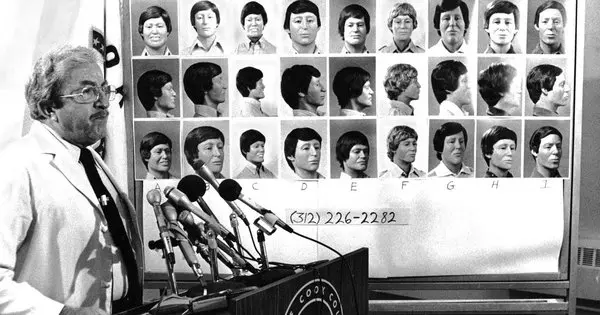
In November 2011, William Bundy was identified through DNA testing.
Possible additional victims
At the time of Gacy’s arrest, he had claimed to investigators that the total number of murder victims could be as high as 45. However, only 33 victims were ever linked to Gacy. Investigators excavated the grounds of his property until they had exposed the substratum of clay beneath the foundations, finding 29 bodies.
Shortly after his arrest, Gacy informed investigators that after he had assaulted and then released Jeffrey Rignall in March 1978, he began to throw his murder victims into the Des Plaines River. He confessed to having disposed of five bodies in this manner; however, only four bodies recovered from the Des Plaines River were linked to him. When asked whether there were more victims, Gacy stated, “That’s for you guys to find out.”
